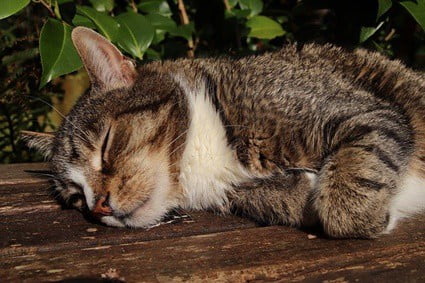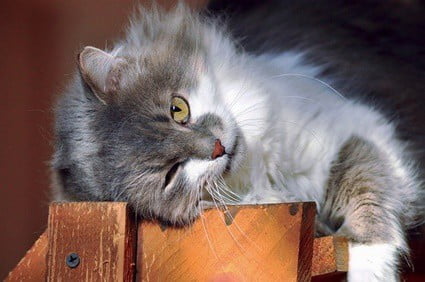Rising temperatures, stress, sickness, excitement, and over-activity initiate a brain response that instructs a cat that it needs to take action to cool down. Given that cats are almost entirely covered in thick fur, they need to use a variety of different methods to disperse any excess body heat.
Cats have eccrine sweat glands in hairless areas of the body, namely their paw pads, nose, lips, chin, and the skin around the anus. Despite the small surface area, the evaporation of sweat has a cooling effect on cats, keeping the feline body temperature between 100 and 102.5 degrees Fahrenheit.
Although cats have wet mouths, tongues, and noses, these aren’t for sweating. So, you shouldn’t see a cat with its tongue out panting like a dog as this is a sign of heatstroke. Cats have better ways of reducing their temperature, such as licking their fur, cooling down as the water evaporates.
Do Cats Have Sweat Glands?
It’s unlikely that an owner will ever see a cat sweating.
Cats only have eccrine sweat glands on the hairless areas of their body, and the surface area is very small. However, on occasion, you may observe feline footprints due to sweating on hot summer days.
When a cat’s body temperature is too high, it’ll send a signal to the brain. In turn, the brain will send a message to the eccrine sweat glands to begin the sweating process to stop a cat from overheating.
How Cats Sweat
While a cat’s cooling system isn’t as comprehensive as ours, it’s still effective.
Cats are homeotherms, which means that they can maintain a relatively constant body temperature of 100° F to 102.5° F.
Skin
Cats have a small number of sweat glands throughout their body, but these are mostly covered by fur.
This minimizes their effect, leading cats to rely on other methods of cooling. Cats also have far fewer sweat glands than humans, so you will rarely see them drenched in sweat when it’s hot.
Paws
You might notice your cat leaving a trail of paw prints across a paved or tiled surface during a period of hot weather. This is sweating in action. A cat’s paw pads contain vital sweat glands that are important for maintaining a healthy body temperature.
Aside from cooling the body, some theories suggest that paw sweat carries and deposits pheromones. These are chemical signals that are species-specific and help cats communicate with other felines.
However, the paws only have a small surface area, which doesn’t lead to significant cooling. Therefore, a cat needs other cooling mechanisms to keep its body at a safe, comfortable temperature.
Nose
A cat’s nose can appear wet because the nose has skin around the nostril opening called the rhinarium. The sweat glands on the rhinarium create moisture. The water on the nose then evaporates (like sweat) on the skin, helping to cool the cat down.
A cat’s interior tear duct also creates drainage that can make a nose wet. Some cats might lick their nose to add another layer of moisture to evaporate to enhance the cooling process.
Sometimes, the reason for a cat’s wet nose is much simpler. Your cat might have recently enjoyed drinking water from its bowl, getting its nose wet in the process.
A dry nose isn’t a cause for concern. If a cat has recently enjoyed a spot of sunbathing, the nose will naturally appear dry where the sun has evaporated the moisture.
How Do Cats Cool Down?
Cats only have a limited number of sweat glands, so sweating isn’t enough to regulate a cat’s body temperature when it begins to overheat. Because of this, grooming can help cool them down. After a cat licks its fur and skin, the saliva evaporates, cooling the skin, much like how sweat evaporates from humans. This technique is used frequently by felines to remove excess heat.
While this behavior is normal, overgrooming due to dry, itchy skin or skin conditions isn’t. Sore skin could be a sign of a health condition. Cats are intelligent animals and will find various ways to reduce their body temperature.

Shaded Areas
Cats will also find a shaded spot to rest in if they become too hot. Stretching out over a cool surface, such as cold tiles or the floor of an air-conditioned room, can reduce body temperature. They will also nap during the day when it gets hot. This is why cats tuck themselves away throughout the day but come alive at night when it’s colder.
Panting
If a cat becomes too hot, it may begin to pant. Panting allows saliva to evaporate from the tongue and is another effective cooling process. Panting should only last a couple of minutes, though. Any longer and your cat may be displaying symptoms of stress or extreme overheating.
If this happens to your cat, intervention could be required. Place your cat in a cool, dark space and provide water. Turn on the air conditioning or place a fan nearby to provide enough airflow to speed up the cooling process.
Shedding Fur
Perhaps surprisingly, fur can prevent the body from absorbing too much heat when it’s warm by slowing down heat absorption. Cats, especially the long-haired kind, will shed their thick undercoats in summer. This undercoat is primarily for trapping heat in winter, so cats don’t need it in warm weather. The remaining outer fur will handle the heat.
While it might seem like a good idea to shave long-haired cats in summer, it can be counterproductive. The fur is an excellent barrier between the sun and a cat’s skin. Without it, a cat is more prone to sunburn and insect bites. Shaving could also lead to dehydration as the cat becomes hotter more quickly.
Do Cats Sweat When Sick?
Cats are stoic animals and will hide when they’re sick. But sweating can be a giveaway sign of illness. Whenever the body is experiencing a rise in temperature, the brain will send signals to the sweat glands to begin sweating.
While it’s difficult to see a cat perspiring, the fur might feel damp in extreme cases. A temperature that’s consistently over 102.8° F is a sign that something is wrong. If a cat has a fever, it may display a reluctance to move, shallow breathing, lethargy, depression, or a lack of appetite.
Cats don’t just sweat due to sickness, though. Excitement or overstimulation can cause an increase in body temperature, which will trigger the sweating process. You may find that your cat keeps its mouth open or begins to pant as it tries to cool itself down.
If your cat calms down after 20 minutes or so, its body temperature is likely starting to regulate naturally. However, if your cat continues to display symptoms of overheating, it’s time to intervene.

Do Cats Sweat When Stressed?
Stress or extreme anxiety can cause a cat to sweat. Have you ever noticed paw prints on the vet’s table during an examination? If so, this is sweat caused by a reaction to stress.
As documented by Science Direct, researchers discovered that 40% of cats had not been to a vet in 2014 compared to 15% of dogs. Cat owners were more reluctant to take cats to the veterinarian due to the stress experienced by both the owner and cat during transport of the cat to and from the veterinary clinic and at the veterinary clinic.
When a cat panics or encounters a stressful situation, the body triggers a rush of adrenaline, cortisol, and other stress hormones. The heart rate increases, and muscles tense to prepare cats to fight or flee. Once these bodily reactions occur, the sweat glands kick in to cool the body down, balance the body’s electrolytes and fluids, and hydrate the skin.
Cats may pant excessively, too. This is part of the cooling down process, but it can appear more troubling than it is. A cat’s body temperature will rise in stressful situations, so it must do what’s necessary to cool itself down.
Does Cat Sweat Smell?
Cats are clean animals and spend 50% of their time grooming themselves. This is for many reasons, including cleaning injuries, removing dirt from their fur, and lubricating the coat and skin. However, one of the most crucial reasons for grooming is that a cat needs to hide its scent from predators. Most predators track prey through scent.
Cats have a heightened sense of smell and can detect the scent of other animals. However, cats’ sweat is odorless to humans. If you’re identifying an unpleasant fragrance from your cat, another reason is likely to be the cause.
This can include skin disease or bacterial infections that create a yeasty body odor. It’s not always unpleasant, but it’s usually distinctive.
A cat’s anal glands can cause musky or fishy odors. These little sac-like glands can become full and emit a foul smell when they need emptying. Owners can empty the glands with careful instruction, or a veterinarian can do it.
Dried feces or urine can leave a nasty odor if left uncleaned. If a cat has a bad stomach or urinary infection and has a toilet-related accident, it may not be able to clean itself. Human help may be required to remove the smell.
While cats don’t have a vast number of sweat glands, they are useful. It’s rare to see a cat actively overheating, and that’s because felines are derived from warmer climes. But not only that, they don’t just rely on their sweating system. They tuck themselves away in shaded areas to keep their body temperature regulated.

